Tuesday, 20 May 2008, The horrors of war
(Written 22 May 2008)
Breakfast at the St. Paul was of the sort where you walk in and sit down and the nice lady brings you a tray with a bread roll, a croissant, butter, and a little pot of jam and asks what you'd like to drink. No decaf, but the tea was good, and David liked the hot chocolate.
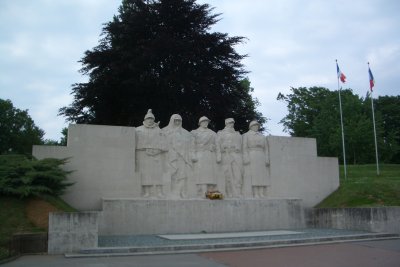
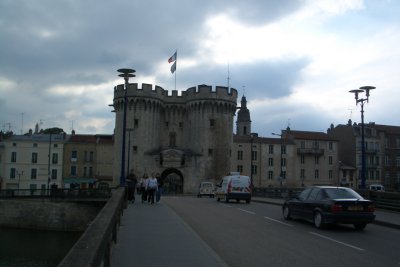 Then it was off to the tourism office to sign up for the battlefield tour and to begin the Michelin walking tour. Like northern Virginia, Gettysburg, and Picardy, Verdun and its surroundings are thickly dotted with monuments and memorials, large and small. Right across from the tourism office is this one. From there, the tour leads across a bridge toward the Porte Chaussée. It and its two crenelated towers were part of the town walls, which stood until 1929.
Then it was off to the tourism office to sign up for the battlefield tour and to begin the Michelin walking tour. Like northern Virginia, Gettysburg, and Picardy, Verdun and its surroundings are thickly dotted with monuments and memorials, large and small. Right across from the tourism office is this one. From there, the tour leads across a bridge toward the Porte Chaussée. It and its two crenelated towers were part of the town walls, which stood until 1929.
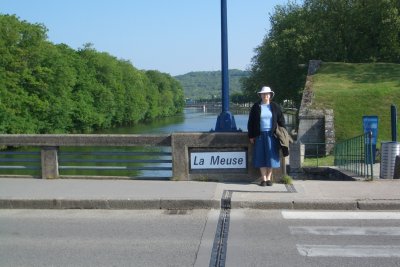
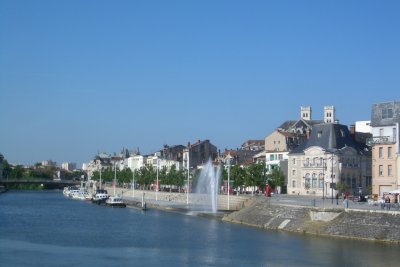
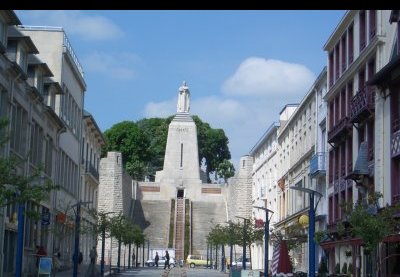 From the bridge, you get lovely views up and down the Meuse river, on your right a rather pastoral scene and on your left the lively downtown waterfront, lined with cafés, chic shops, and pleasure boats. The fountain marks the central intersection where Le Coq Hardi (our restaurant) is located. It's at the foot of a pedestrian street that rises several blocks from the fountain to the foot of a gigantic Monument to Victory, simply inscribed "Verdun," depicting a single warrior whose hands rest on the hilt of his sword. You have to climb 73 steps just to reach the base of the pedestal. From a pool at the base of the pedestal, water pours down a central set of steps, then passes down a shallow central channel down the center of the street to empty into the river at the large fountain. The channel is roofed with marble slabs pierced by two-inch round holes. When only a moderate amount of water is flowing, you can hear it below your feet, but as the amount increases (depending, I suppose, on rainfall or season), it begins to shoot up through the holes to form smaller fountains the length of the street. When we first saw it, only intermittent six-inch spurts were emerging from the lowest slab, nearest the river. The next day, steady six-inch fountains were playing along its whole length. A very interesting fountain.
From the bridge, you get lovely views up and down the Meuse river, on your right a rather pastoral scene and on your left the lively downtown waterfront, lined with cafés, chic shops, and pleasure boats. The fountain marks the central intersection where Le Coq Hardi (our restaurant) is located. It's at the foot of a pedestrian street that rises several blocks from the fountain to the foot of a gigantic Monument to Victory, simply inscribed "Verdun," depicting a single warrior whose hands rest on the hilt of his sword. You have to climb 73 steps just to reach the base of the pedestal. From a pool at the base of the pedestal, water pours down a central set of steps, then passes down a shallow central channel down the center of the street to empty into the river at the large fountain. The channel is roofed with marble slabs pierced by two-inch round holes. When only a moderate amount of water is flowing, you can hear it below your feet, but as the amount increases (depending, I suppose, on rainfall or season), it begins to shoot up through the holes to form smaller fountains the length of the street. When we first saw it, only intermittent six-inch spurts were emerging from the lowest slab, nearest the river. The next day, steady six-inch fountains were playing along its whole length. A very interesting fountain.
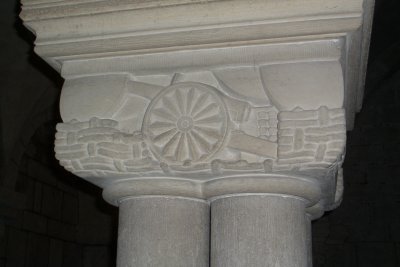 We spent the morning doing the Michelin walking tour of the town, which included the monuments described above; a bronze statue of "Defense" by Rodin that was given to Verdun by the Netherlands, in gratitude for its role in stopping the Germans; the cathedral, in the crypt of which are some low columns with capitals depicting scenes of WWI; the episcopal palace, which now houses the Centre Mondial de la Paix (World Center for Peace); and a couple more residual gates in the city wall.
We spent the morning doing the Michelin walking tour of the town, which included the monuments described above; a bronze statue of "Defense" by Rodin that was given to Verdun by the Netherlands, in gratitude for its role in stopping the Germans; the cathedral, in the crypt of which are some low columns with capitals depicting scenes of WWI; the episcopal palace, which now houses the Centre Mondial de la Paix (World Center for Peace); and a couple more residual gates in the city wall.
On the way back from the end of the tour, we stopped in at a hat shop (the tourism office people told us where to find it) and bought David a new (sort of) Panama hat. The two-tone leather band is a bit Indiana Jones, but now that he's no longer chairman, he doesn't have to wear it to the dean's office any more.
For lunch, we just went back to the informal "bistro" side of the Coq Hardi, where we both chose (from section of the menu labeled "just a snack," since they aren't large enough to be considered lunch) three-egg omelets with (European style) bacon, potatoes, cheese, and fresh chives, sided by escarole in a sharp, mustardy vinaigrette. Delicious. For dessert, we split a chocolate eclaire.
Then came the afternoon's excursion to the battlefields by bus. Only 13 people showed up, so we had quite an intimate tour. The major features we visited were an especially large French military cemetery, including over 5000 graves (and remember that, rather than gathering them together into large central cemeteries like the Americans, the French buried their dead near where they fell; they lost far more than that at Verdun—these are just the ones who were identified, whose families didn't pay to have them moved later, etc.), the "tranchée des bayonnettes" (bayonnet trench), the Fort de Douaumont, the Douaumont Ossuary, and the official French Verdun memorial and museum. Just in passing, we saw the monument marking the spot where Maginot was killed, a sculpture of a dying lion marking the German "high tide" (point of furthest advance), the separate monuments to muslim and jewish soldiers who died for France, a WWII memorial to some people who were executed by firing squad at Tavannes, and various markers indicating the locations of the eight or so villages that were entirely destroyed and never rebuilt.
Before the battle, most of the land was in cultivation and was therefore rather open; after it, the landscape was nothing but ploughed soil as far as the eye could see, thickly (very thickly, every couple of inches, to a depth of a couple of feet) studded with shards of metal, broken-down equipment, body parts (several layers of them), smashed helmets, and unexploded ordnance. (The experts who've been working ever since to clear the areas say it will be 500 years before the last of the dangerous ordnance is gone.) As in parts of Picardy, a shell fell, on average, every meter, and each blew a 5- to 10-meter hole. When the farmers came back to their land after the war, they not only couldn't find where their houses had been—they often couldn't even find their land, and these were people intimately acquainted with the local topography. And the land couldn't be farmed anyway; the soil was polluted with blood, decaying flesh, iron, and gunpowder, and you couldn't sink a shovel without hitting a skull, or an old wheel rim, or a piece of shrapnel, or a shell that blew up in your face. The French government therefore stepped in, bought up the whole battlefield, and ruled that it was too sacred for commercial use anyway. They planted trees, so now the whole area is heavily forested. Signs everywhere warn you not to leave the roads and marked paths, for fear of explosives.
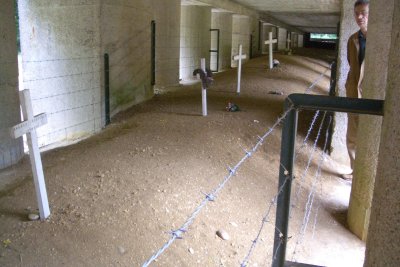 The story of the "tranchée des bayonnettes" that was told for decades, until quite recently, was that two companies of French soldiers (say a couple of hundred men) were buried alive in their trenches, standing up, with their rifles in their hands, when a particularly severe artillery bombardment caused the trenches to collapse suddenly. Only the bayonnets on the ends of their rifle barrels protruded above ground to mark the spot. Recently, archeological digs have revealed that the real story is probably that the trenches were empty when the Germans got to them (the French soldiers having left them to launch their attack) and that the Germans used them as impromptu graves, indiscrimantly heaving hundreds of bodies into them, filling them in, and leaving bayonets standing to mark the trench as a tomb. The trench was at least a kilometer long, but the section where the most bodies were found is now covered by a sort of concrete canopy and preserved as a memorial. Unfortunately, the bayonnets were stolen and replaced 23 times before, in the early 1950's, they were set in concrete in preparation for an important state visit. Since them they have all been broken off and stolen. Even the copper sheeting that protects the concrete roof from the weather is bent and dented from a recent attempt to rip it loose and steal it.
The story of the "tranchée des bayonnettes" that was told for decades, until quite recently, was that two companies of French soldiers (say a couple of hundred men) were buried alive in their trenches, standing up, with their rifles in their hands, when a particularly severe artillery bombardment caused the trenches to collapse suddenly. Only the bayonnets on the ends of their rifle barrels protruded above ground to mark the spot. Recently, archeological digs have revealed that the real story is probably that the trenches were empty when the Germans got to them (the French soldiers having left them to launch their attack) and that the Germans used them as impromptu graves, indiscrimantly heaving hundreds of bodies into them, filling them in, and leaving bayonets standing to mark the trench as a tomb. The trench was at least a kilometer long, but the section where the most bodies were found is now covered by a sort of concrete canopy and preserved as a memorial. Unfortunately, the bayonnets were stolen and replaced 23 times before, in the early 1950's, they were set in concrete in preparation for an important state visit. Since them they have all been broken off and stolen. Even the copper sheeting that protects the concrete roof from the weather is bent and dented from a recent attempt to rip it loose and steal it.
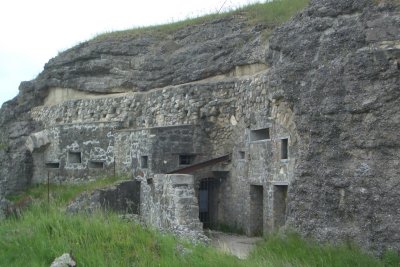 The Fort de Douaumont, like most of those in the area, is underground, as the invention of serious artillery had rendered ordinary stone walls obsolete. Here you see a few windows cut into the back of it, at the highest level. Even with 9 meters of stone, concrete, sand, and soil overhead, some of the compartments were caved in by artillery shells, some of which weighed a ton at launch. The fort changed hands a couple of times, and at one point while it was occupied by the Germans, the gasoline storage tank caught fire and set off in turn all the stored flamethrowers and the ammunition magazine. 800 men died, and the stone-lined walls of the tunnel were actually bulged outward by the force of the explosion. Those men and some French soldiers who died in a cave-in are buried right there in the fort, in sealed-off casemates. Consensus among the French soldiers was apparently that conditions outside the fort were hell (life expectancy in no-man's-land was apparently less than 1 second) but that life inside was worse. Besides the bad air, heavier-than-air poison gas that leaked in and swirled around on the floor, bad food, damp, dark, cold, crowding, lice and other vermin, and stench (the smell of about 800 men who had no opportunity to wash and were forbidden to take off their uniforms or boots even to sleep, excrement from 8 latrines—not 8 rooms of latrines but one room containing 8 individual "toilets," initially large jerrycans but later pits covered with manhole-sized gratings—serving those 800 men, vomit, gangrene, etc.), there was the noise. To illustrate it, our guide stood a half-inch thick iron flitch plate about 4 feet square up on edge, then let it fall over onto the stone floor—ow!—to illustrate the noise made in the trench by a hit from a 100-pound shell. Then she explained that the Germans mostly used one-ton shells and that the fort was often hit by about 200-300 of them a day. Some men went deaf; many went insane. The Germans added electric lighting, using bare wires and very dim bulbs, and lost a surprising number of people to electrocution.
The Fort de Douaumont, like most of those in the area, is underground, as the invention of serious artillery had rendered ordinary stone walls obsolete. Here you see a few windows cut into the back of it, at the highest level. Even with 9 meters of stone, concrete, sand, and soil overhead, some of the compartments were caved in by artillery shells, some of which weighed a ton at launch. The fort changed hands a couple of times, and at one point while it was occupied by the Germans, the gasoline storage tank caught fire and set off in turn all the stored flamethrowers and the ammunition magazine. 800 men died, and the stone-lined walls of the tunnel were actually bulged outward by the force of the explosion. Those men and some French soldiers who died in a cave-in are buried right there in the fort, in sealed-off casemates. Consensus among the French soldiers was apparently that conditions outside the fort were hell (life expectancy in no-man's-land was apparently less than 1 second) but that life inside was worse. Besides the bad air, heavier-than-air poison gas that leaked in and swirled around on the floor, bad food, damp, dark, cold, crowding, lice and other vermin, and stench (the smell of about 800 men who had no opportunity to wash and were forbidden to take off their uniforms or boots even to sleep, excrement from 8 latrines—not 8 rooms of latrines but one room containing 8 individual "toilets," initially large jerrycans but later pits covered with manhole-sized gratings—serving those 800 men, vomit, gangrene, etc.), there was the noise. To illustrate it, our guide stood a half-inch thick iron flitch plate about 4 feet square up on edge, then let it fall over onto the stone floor—ow!—to illustrate the noise made in the trench by a hit from a 100-pound shell. Then she explained that the Germans mostly used one-ton shells and that the fort was often hit by about 200-300 of them a day. Some men went deaf; many went insane. The Germans added electric lighting, using bare wires and very dim bulbs, and lost a surprising number of people to electrocution.
The museum at the memorial was excellent. David could have spent days in there, rather than the hour we were allotted. The most interesting for me was the mobile "field kitchens," arrangements of four metal kettles, each with a lid that could be clamped on, set into a common fire-box with a central chimney, the whole thing mounted on wheels and designed to be hauled behind a small wagon fitted with iron "kitchen cabinets." By the length of the single-tree, I'd say each was pulled by four to six horses or mules.
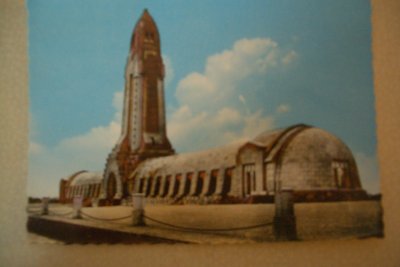 The Douaumont Ossuary was perhaps the most amazing of all. It consists of three long, low wings that radiate from the base of a central tower, two of them colinear and the third at right angles. The central tower is in the shape of a cannonshell, with a huge cross carved on each side. The ends of the hemicylindrical wings are reminiscent of the rounded concrete bunkers so common everywhere in northern France. Inside, each of the wings is lined on both sides with long rows of cenotaphs (resembling large marble sarcophagi), one for each "sector" of the battlefield, and below them (below floor level) are large bins. In those bins are the bones of the unidentified dead. For years after the end of the war, bones were everywhere, and a local priest simply spread the word than any human bone anyone found should be brought to him. He organized the movement that eventually raised enough money to build the ossuary, which now contains the remains of at least 130,000 unidentified French and German soldiers. At least as many more are thought still to lie on and in the battlefield; bones continue to be found and added. Extra-large bins at the ends of the wings take the overflow from particularly "populous" sectors. The family of any (French) soldier missing and presumed dead from the battle of Verdun can request that his name be engraved on a plaque in the wall, and names are still being added; one was being engraved when we were there. German families come to visit the site as well, but they are not permitted to add names to the walls. Outside the building is another French national cemetery, and through small windows set into the building's foundation, near ground level, you can look in to see the actual bones.
The Douaumont Ossuary was perhaps the most amazing of all. It consists of three long, low wings that radiate from the base of a central tower, two of them colinear and the third at right angles. The central tower is in the shape of a cannonshell, with a huge cross carved on each side. The ends of the hemicylindrical wings are reminiscent of the rounded concrete bunkers so common everywhere in northern France. Inside, each of the wings is lined on both sides with long rows of cenotaphs (resembling large marble sarcophagi), one for each "sector" of the battlefield, and below them (below floor level) are large bins. In those bins are the bones of the unidentified dead. For years after the end of the war, bones were everywhere, and a local priest simply spread the word than any human bone anyone found should be brought to him. He organized the movement that eventually raised enough money to build the ossuary, which now contains the remains of at least 130,000 unidentified French and German soldiers. At least as many more are thought still to lie on and in the battlefield; bones continue to be found and added. Extra-large bins at the ends of the wings take the overflow from particularly "populous" sectors. The family of any (French) soldier missing and presumed dead from the battle of Verdun can request that his name be engraved on a plaque in the wall, and names are still being added; one was being engraved when we were there. German families come to visit the site as well, but they are not permitted to add names to the walls. Outside the building is another French national cemetery, and through small windows set into the building's foundation, near ground level, you can look in to see the actual bones.
As our bus left, the guide recommended we look back at the view of the ossuary, which she says is intended also to represent, when viewed from the front, with the third wing hidden (as in this rather blurry photo of a postcard), the hilt of a giant sword thrust straight downward into the earth, never, one hopes, to be used again.
The bus tour got us back in time to clean up and change for our second dinner at Le Coq Hardi. This time, we stepped up to the next more elaborate menu:
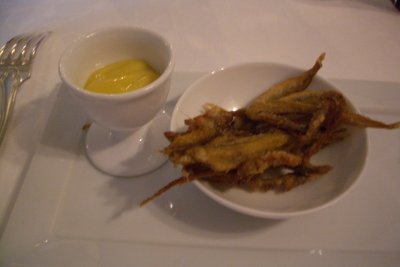 Amuse-bouche, both: "Friture" of "équilles" (Ammodytes tobianus, in the family Ammodytidae, the sand eels), tiny, long, skinny, whole, deep-fried fish, accompanied by a small wedge of lemon and a saffron aioli. David ate a few, then gave the rest to me. I thought they were great!
Amuse-bouche, both: "Friture" of "équilles" (Ammodytes tobianus, in the family Ammodytidae, the sand eels), tiny, long, skinny, whole, deep-fried fish, accompanied by a small wedge of lemon and a saffron aioli. David ate a few, then gave the rest to me. I thought they were great!
First course, David: Consommé of morels and crayfish tails.
First course, me: Duck foie gras, sautéed with red currants.
Second course, David: Sautéed green asparagus with shaved Parma ham. Excellent.
Second course, me: Chunk of small turbot, on a bed of baby broad beans cooked with tomato. Okay, but nothing to rave about.
Third course, both: Cross-section of a large sole "à la Grenobloise," which means grilled and dressed with peeled lemon segments, capers, and croutons. Much better than the turbot.
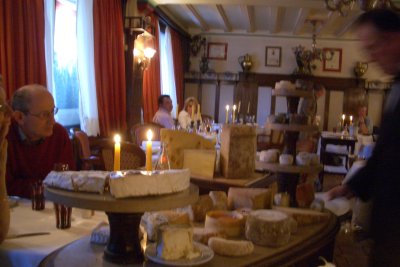 Cheese course: The cheeses were amazing. In the photo, you can see that they have not one but two cheese trolleys. On the nearer one, at the near end, is their local Brie on its own wooden pedestal. Beyond that a whole selection of medium-sized cheese, then a multi-tiered wooden pedestal loaded with all the small chevres. Beyond that is the second trolley, loaded with gargantuan wedges of three large cheeses: an ementhal (with the holes), a Beaufort (the smallest), and a Salers (the largest). David chose some Roquefort, some Beaufort, and a reblochon that was making an active break for it, but he scooped it up off the plate before it escaped and ate it with a spoon. I had an almost equally liquid chaource, a slice of an unashed St. Maur, and a slab of the Salers. Wow. We both declared it among the top three cheese courses ever! Outstanding!
Cheese course: The cheeses were amazing. In the photo, you can see that they have not one but two cheese trolleys. On the nearer one, at the near end, is their local Brie on its own wooden pedestal. Beyond that a whole selection of medium-sized cheese, then a multi-tiered wooden pedestal loaded with all the small chevres. Beyond that is the second trolley, loaded with gargantuan wedges of three large cheeses: an ementhal (with the holes), a Beaufort (the smallest), and a Salers (the largest). David chose some Roquefort, some Beaufort, and a reblochon that was making an active break for it, but he scooped it up off the plate before it escaped and ate it with a spoon. I had an almost equally liquid chaource, a slice of an unashed St. Maur, and a slab of the Salers. Wow. We both declared it among the top three cheese courses ever! Outstanding!
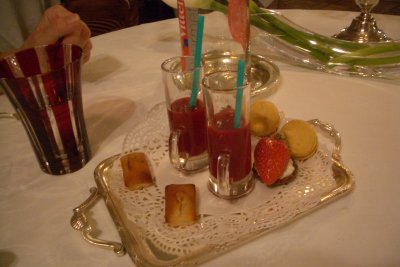 The mignardises were served as a predessert, and the little raspberry milkshakes were delicious.
The mignardises were served as a predessert, and the little raspberry milkshakes were delicious.
Dessert, David: An early yellow peach poached in lemon verbena syrup and accompanied by a tuile cookie, vanilla ice cream, a large raspberry, and a spray of fresh red currants.
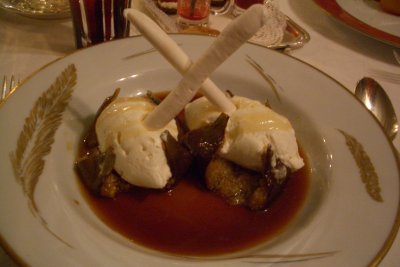 Dessert, me: Two large roasted figs, quartered and filled with honey-drizzled whipped cream, lying in a pool of port wine syrup and garnished with crisp meringue sticks. Yummy!
Dessert, me: Two large roasted figs, quartered and filled with honey-drizzled whipped cream, lying in a pool of port wine syrup and garnished with crisp meringue sticks. Yummy!
previous entry
List of Entries
next entry

 Then it was off to the tourism office to sign up for the battlefield tour and to begin the Michelin walking tour. Like northern Virginia, Gettysburg, and Picardy, Verdun and its surroundings are thickly dotted with monuments and memorials, large and small. Right across from the tourism office is this one. From there, the tour leads across a bridge toward the Porte Chaussée. It and its two crenelated towers were part of the town walls, which stood until 1929.
Then it was off to the tourism office to sign up for the battlefield tour and to begin the Michelin walking tour. Like northern Virginia, Gettysburg, and Picardy, Verdun and its surroundings are thickly dotted with monuments and memorials, large and small. Right across from the tourism office is this one. From there, the tour leads across a bridge toward the Porte Chaussée. It and its two crenelated towers were part of the town walls, which stood until 1929.

 From the bridge, you get lovely views up and down the Meuse river, on your right a rather pastoral scene and on your left the lively downtown waterfront, lined with cafés, chic shops, and pleasure boats. The fountain marks the central intersection where Le Coq Hardi (our restaurant) is located. It's at the foot of a pedestrian street that rises several blocks from the fountain to the foot of a gigantic Monument to Victory, simply inscribed "Verdun," depicting a single warrior whose hands rest on the hilt of his sword. You have to climb 73 steps just to reach the base of the pedestal. From a pool at the base of the pedestal, water pours down a central set of steps, then passes down a shallow central channel down the center of the street to empty into the river at the large fountain. The channel is roofed with marble slabs pierced by two-inch round holes. When only a moderate amount of water is flowing, you can hear it below your feet, but as the amount increases (depending, I suppose, on rainfall or season), it begins to shoot up through the holes to form smaller fountains the length of the street. When we first saw it, only intermittent six-inch spurts were emerging from the lowest slab, nearest the river. The next day, steady six-inch fountains were playing along its whole length. A very interesting fountain.
From the bridge, you get lovely views up and down the Meuse river, on your right a rather pastoral scene and on your left the lively downtown waterfront, lined with cafés, chic shops, and pleasure boats. The fountain marks the central intersection where Le Coq Hardi (our restaurant) is located. It's at the foot of a pedestrian street that rises several blocks from the fountain to the foot of a gigantic Monument to Victory, simply inscribed "Verdun," depicting a single warrior whose hands rest on the hilt of his sword. You have to climb 73 steps just to reach the base of the pedestal. From a pool at the base of the pedestal, water pours down a central set of steps, then passes down a shallow central channel down the center of the street to empty into the river at the large fountain. The channel is roofed with marble slabs pierced by two-inch round holes. When only a moderate amount of water is flowing, you can hear it below your feet, but as the amount increases (depending, I suppose, on rainfall or season), it begins to shoot up through the holes to form smaller fountains the length of the street. When we first saw it, only intermittent six-inch spurts were emerging from the lowest slab, nearest the river. The next day, steady six-inch fountains were playing along its whole length. A very interesting fountain. We spent the morning doing the Michelin walking tour of the town, which included the monuments described above; a bronze statue of "Defense" by Rodin that was given to Verdun by the Netherlands, in gratitude for its role in stopping the Germans; the cathedral, in the crypt of which are some low columns with capitals depicting scenes of WWI; the episcopal palace, which now houses the Centre Mondial de la Paix (World Center for Peace); and a couple more residual gates in the city wall.
We spent the morning doing the Michelin walking tour of the town, which included the monuments described above; a bronze statue of "Defense" by Rodin that was given to Verdun by the Netherlands, in gratitude for its role in stopping the Germans; the cathedral, in the crypt of which are some low columns with capitals depicting scenes of WWI; the episcopal palace, which now houses the Centre Mondial de la Paix (World Center for Peace); and a couple more residual gates in the city wall. The story of the "tranchée des bayonnettes" that was told for decades, until quite recently, was that two companies of French soldiers (say a couple of hundred men) were buried alive in their trenches, standing up, with their rifles in their hands, when a particularly severe artillery bombardment caused the trenches to collapse suddenly. Only the bayonnets on the ends of their rifle barrels protruded above ground to mark the spot. Recently, archeological digs have revealed that the real story is probably that the trenches were empty when the Germans got to them (the French soldiers having left them to launch their attack) and that the Germans used them as impromptu graves, indiscrimantly heaving hundreds of bodies into them, filling them in, and leaving bayonets standing to mark the trench as a tomb. The trench was at least a kilometer long, but the section where the most bodies were found is now covered by a sort of concrete canopy and preserved as a memorial. Unfortunately, the bayonnets were stolen and replaced 23 times before, in the early 1950's, they were set in concrete in preparation for an important state visit. Since them they have all been broken off and stolen. Even the copper sheeting that protects the concrete roof from the weather is bent and dented from a recent attempt to rip it loose and steal it.
The story of the "tranchée des bayonnettes" that was told for decades, until quite recently, was that two companies of French soldiers (say a couple of hundred men) were buried alive in their trenches, standing up, with their rifles in their hands, when a particularly severe artillery bombardment caused the trenches to collapse suddenly. Only the bayonnets on the ends of their rifle barrels protruded above ground to mark the spot. Recently, archeological digs have revealed that the real story is probably that the trenches were empty when the Germans got to them (the French soldiers having left them to launch their attack) and that the Germans used them as impromptu graves, indiscrimantly heaving hundreds of bodies into them, filling them in, and leaving bayonets standing to mark the trench as a tomb. The trench was at least a kilometer long, but the section where the most bodies were found is now covered by a sort of concrete canopy and preserved as a memorial. Unfortunately, the bayonnets were stolen and replaced 23 times before, in the early 1950's, they were set in concrete in preparation for an important state visit. Since them they have all been broken off and stolen. Even the copper sheeting that protects the concrete roof from the weather is bent and dented from a recent attempt to rip it loose and steal it. The Fort de Douaumont, like most of those in the area, is underground, as the invention of serious artillery had rendered ordinary stone walls obsolete. Here you see a few windows cut into the back of it, at the highest level. Even with 9 meters of stone, concrete, sand, and soil overhead, some of the compartments were caved in by artillery shells, some of which weighed a ton at launch. The fort changed hands a couple of times, and at one point while it was occupied by the Germans, the gasoline storage tank caught fire and set off in turn all the stored flamethrowers and the ammunition magazine. 800 men died, and the stone-lined walls of the tunnel were actually bulged outward by the force of the explosion. Those men and some French soldiers who died in a cave-in are buried right there in the fort, in sealed-off casemates. Consensus among the French soldiers was apparently that conditions outside the fort were hell (life expectancy in no-man's-land was apparently less than 1 second) but that life inside was worse. Besides the bad air, heavier-than-air poison gas that leaked in and swirled around on the floor, bad food, damp, dark, cold, crowding, lice and other vermin, and stench (the smell of about 800 men who had no opportunity to wash and were forbidden to take off their uniforms or boots even to sleep, excrement from 8 latrines—not 8 rooms of latrines but one room containing 8 individual "toilets," initially large jerrycans but later pits covered with manhole-sized gratings—serving those 800 men, vomit, gangrene, etc.), there was the noise. To illustrate it, our guide stood a half-inch thick iron flitch plate about 4 feet square up on edge, then let it fall over onto the stone floor—ow!—to illustrate the noise made in the trench by a hit from a 100-pound shell. Then she explained that the Germans mostly used one-ton shells and that the fort was often hit by about 200-300 of them a day. Some men went deaf; many went insane. The Germans added electric lighting, using bare wires and very dim bulbs, and lost a surprising number of people to electrocution.
The Fort de Douaumont, like most of those in the area, is underground, as the invention of serious artillery had rendered ordinary stone walls obsolete. Here you see a few windows cut into the back of it, at the highest level. Even with 9 meters of stone, concrete, sand, and soil overhead, some of the compartments were caved in by artillery shells, some of which weighed a ton at launch. The fort changed hands a couple of times, and at one point while it was occupied by the Germans, the gasoline storage tank caught fire and set off in turn all the stored flamethrowers and the ammunition magazine. 800 men died, and the stone-lined walls of the tunnel were actually bulged outward by the force of the explosion. Those men and some French soldiers who died in a cave-in are buried right there in the fort, in sealed-off casemates. Consensus among the French soldiers was apparently that conditions outside the fort were hell (life expectancy in no-man's-land was apparently less than 1 second) but that life inside was worse. Besides the bad air, heavier-than-air poison gas that leaked in and swirled around on the floor, bad food, damp, dark, cold, crowding, lice and other vermin, and stench (the smell of about 800 men who had no opportunity to wash and were forbidden to take off their uniforms or boots even to sleep, excrement from 8 latrines—not 8 rooms of latrines but one room containing 8 individual "toilets," initially large jerrycans but later pits covered with manhole-sized gratings—serving those 800 men, vomit, gangrene, etc.), there was the noise. To illustrate it, our guide stood a half-inch thick iron flitch plate about 4 feet square up on edge, then let it fall over onto the stone floor—ow!—to illustrate the noise made in the trench by a hit from a 100-pound shell. Then she explained that the Germans mostly used one-ton shells and that the fort was often hit by about 200-300 of them a day. Some men went deaf; many went insane. The Germans added electric lighting, using bare wires and very dim bulbs, and lost a surprising number of people to electrocution. The Douaumont Ossuary was perhaps the most amazing of all. It consists of three long, low wings that radiate from the base of a central tower, two of them colinear and the third at right angles. The central tower is in the shape of a cannonshell, with a huge cross carved on each side. The ends of the hemicylindrical wings are reminiscent of the rounded concrete bunkers so common everywhere in northern France. Inside, each of the wings is lined on both sides with long rows of cenotaphs (resembling large marble sarcophagi), one for each "sector" of the battlefield, and below them (below floor level) are large bins. In those bins are the bones of the unidentified dead. For years after the end of the war, bones were everywhere, and a local priest simply spread the word than any human bone anyone found should be brought to him. He organized the movement that eventually raised enough money to build the ossuary, which now contains the remains of at least 130,000 unidentified French and German soldiers. At least as many more are thought still to lie on and in the battlefield; bones continue to be found and added. Extra-large bins at the ends of the wings take the overflow from particularly "populous" sectors. The family of any (French) soldier missing and presumed dead from the battle of Verdun can request that his name be engraved on a plaque in the wall, and names are still being added; one was being engraved when we were there. German families come to visit the site as well, but they are not permitted to add names to the walls. Outside the building is another French national cemetery, and through small windows set into the building's foundation, near ground level, you can look in to see the actual bones.
The Douaumont Ossuary was perhaps the most amazing of all. It consists of three long, low wings that radiate from the base of a central tower, two of them colinear and the third at right angles. The central tower is in the shape of a cannonshell, with a huge cross carved on each side. The ends of the hemicylindrical wings are reminiscent of the rounded concrete bunkers so common everywhere in northern France. Inside, each of the wings is lined on both sides with long rows of cenotaphs (resembling large marble sarcophagi), one for each "sector" of the battlefield, and below them (below floor level) are large bins. In those bins are the bones of the unidentified dead. For years after the end of the war, bones were everywhere, and a local priest simply spread the word than any human bone anyone found should be brought to him. He organized the movement that eventually raised enough money to build the ossuary, which now contains the remains of at least 130,000 unidentified French and German soldiers. At least as many more are thought still to lie on and in the battlefield; bones continue to be found and added. Extra-large bins at the ends of the wings take the overflow from particularly "populous" sectors. The family of any (French) soldier missing and presumed dead from the battle of Verdun can request that his name be engraved on a plaque in the wall, and names are still being added; one was being engraved when we were there. German families come to visit the site as well, but they are not permitted to add names to the walls. Outside the building is another French national cemetery, and through small windows set into the building's foundation, near ground level, you can look in to see the actual bones. Amuse-bouche, both: "Friture" of "équilles" (Ammodytes tobianus, in the family Ammodytidae, the sand eels), tiny, long, skinny, whole, deep-fried fish, accompanied by a small wedge of lemon and a saffron aioli. David ate a few, then gave the rest to me. I thought they were great!
Amuse-bouche, both: "Friture" of "équilles" (Ammodytes tobianus, in the family Ammodytidae, the sand eels), tiny, long, skinny, whole, deep-fried fish, accompanied by a small wedge of lemon and a saffron aioli. David ate a few, then gave the rest to me. I thought they were great! Cheese course: The cheeses were amazing. In the photo, you can see that they have not one but two cheese trolleys. On the nearer one, at the near end, is their local Brie on its own wooden pedestal. Beyond that a whole selection of medium-sized cheese, then a multi-tiered wooden pedestal loaded with all the small chevres. Beyond that is the second trolley, loaded with gargantuan wedges of three large cheeses: an ementhal (with the holes), a Beaufort (the smallest), and a Salers (the largest). David chose some Roquefort, some Beaufort, and a reblochon that was making an active break for it, but he scooped it up off the plate before it escaped and ate it with a spoon. I had an almost equally liquid chaource, a slice of an unashed St. Maur, and a slab of the Salers. Wow. We both declared it among the top three cheese courses ever! Outstanding!
Cheese course: The cheeses were amazing. In the photo, you can see that they have not one but two cheese trolleys. On the nearer one, at the near end, is their local Brie on its own wooden pedestal. Beyond that a whole selection of medium-sized cheese, then a multi-tiered wooden pedestal loaded with all the small chevres. Beyond that is the second trolley, loaded with gargantuan wedges of three large cheeses: an ementhal (with the holes), a Beaufort (the smallest), and a Salers (the largest). David chose some Roquefort, some Beaufort, and a reblochon that was making an active break for it, but he scooped it up off the plate before it escaped and ate it with a spoon. I had an almost equally liquid chaource, a slice of an unashed St. Maur, and a slab of the Salers. Wow. We both declared it among the top three cheese courses ever! Outstanding! The mignardises were served as a predessert, and the little raspberry milkshakes were delicious.
The mignardises were served as a predessert, and the little raspberry milkshakes were delicious. Dessert, me: Two large roasted figs, quartered and filled with honey-drizzled whipped cream, lying in a pool of port wine syrup and garnished with crisp meringue sticks. Yummy!
Dessert, me: Two large roasted figs, quartered and filled with honey-drizzled whipped cream, lying in a pool of port wine syrup and garnished with crisp meringue sticks. Yummy!